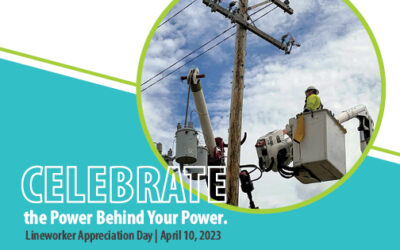
As a not-for-profit utility, Dawson PPD focuses on cost-effectively extending the life of its existing facilities while maintaining adequate levels of safety and reliability. Testing wooden poles helps the District ensure reliability and long life of its equipment, saving customers money in the long run.
Traditionally, pole testing involved a hammer for sounding, a shovel for digging around the base and drilling holes to test for decay. Today, Dawson PPD hires a contractor that uses a scientifically-based system called POLUX as a less-invasive and more accurate form of testing.
POLUX works by sending two, three inch long probes the size of an eight-penny nail into the base of the utility pole. This is the most vulnerable point where decay is most likely to occur on a pole. The probes measure resistance and moisture content of the pole. This information, along with the type of wood the pole is made of and how it was treated are run through a computer program with the pole’s GPS location recorded.
Typically, Dawson PPD uses a Southern Yellow Pine tree for its poles, which should have a resistance of 8,000 pounds per square inch when new. If the measurement falls below 50 percent of the recommended resistance, in this case 4,000 PSI, the pole is marked for replacement.
All of Dawson PPD’s poles are tested every 10 years on a rotating schedule with 10,000-11,000 poles tested annually.
OTHER NEWS
Laguna-Gutierrez receives $2,000 Dawson PPD Utility Line Scholarship
Dawson Public Power District has awarded Juan Laguna-Gutierrez a $2,000 utility line scholarship to pursue his degree. Laguna-Gutierrez is a student at Lexington High School and is the son of Juan Laguna-Sanchez and Alejandra Gutierrez-Alvarado.
Wulf awarded $2,000 Dawson PPD STEM Scholarship
Kearney native Hayden Wulf has been awarded a $2,000 STEM Scholarship from Dawson Public Power District. Wulf is the daughter of Douglas and Kellie Wulf. She is currently studying Civil Engineering at the University of Nebraska-Lincoln.
April 10 is National Lineworker Appreciation Day
Celebrate the power behind your power. This Lineworker Appreciation Day, Dawson PPD invites our customers to recognize our local line crews and all utility lineworkers across America. Our lineworkers’ top priority is ensuring that we have reliable electricity for everyday life. Got power? Thank a lineworker!



